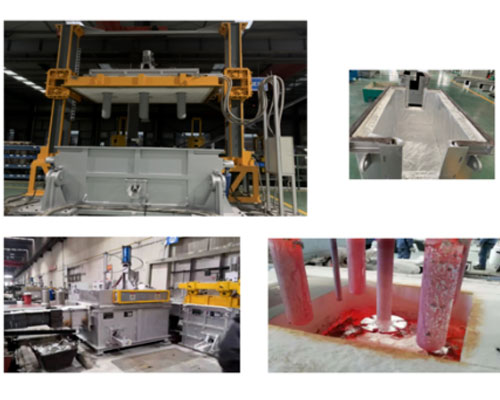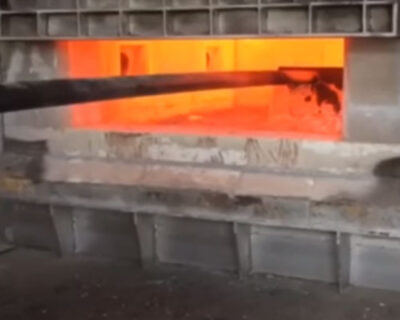Molten aluminium is an alloyed aluminum and aluminum alloy high-temperature liquid formed by directly or mixing primary aluminum (aluminum ingot or electrolytic aluminum) with other alloying elements through a high-temperature smelting method. During the smelting of aluminum and aluminum alloys, oxidized slag and gettering will be accompanied, which will cause high-temperature aluminum liquid to be contaminated by impurities to varying degrees. Especially, aluminum and aluminum alloy melts contain a large amount of hydrogen, metal and non-metallic inclusions. If the above harmful substances cannot be removed in time before casting, casting defects such as pores, inclusions, and looseness will be formed inside and on the surface of the casting, which will seriously affect the physical, chemical, mechanical and various deep processing properties of the casting, resulting in a large amount of waste. Therefore, molten aluminium needs to be purified. At present, the molten aluminium purification technology includes two kinds of purification in the furnace and purification outside the furnace.
Furnace purification technology is a kind of molten aluminium purification technology adopted in the aluminum melting furnace in the process of aluminum and aluminum alloy smelting, including degassing and slag removal.
The technology can be divided into adsorption purification treatment technology and non-adsorption purification treatment technology:
The adsorption method mainly relies on the flux to produce the effect of absorbing rigid oxidation inclusions, and at the same time remove the oxidation inclusions and the adsorbed hydrogen on the surface to achieve the purpose of purifying molten aluminum. The purification effect of the adsorption method only occurs at the adsorption interface. The adsorption method mainly includes single gas purging, mixed gas purging, chlorine salt purification, and flux method refining.
The non-adsorption method mainly relies on other physical and chemical effects to achieve the purpose of purifying the aluminum liquid. The non-adsorption method mainly includes vacuum purification treatment (static vacuum treatment, dynamic vacuum treatment), ultrasonic purification treatment, electromagnetic purification treatment, and pressure crystallization Method, rare earth element solid hydrogen method, etc.
The molten aluminium purification (degassing and filtration) technology outside the furnace is an online degassing and slagging technology used in the process of casting of molten aluminum. The degassing (hydrogen) purification method outside the furnace is actually the bubble floatation method, which is passed A certain method produces a large number of bubbles in the molten aluminum, using the partial pressure difference between the hydrogen in the molten aluminum and the bubbles, so that the hydrogen in the molten aluminum continuously enters the bubbles and floats in the molten aluminum, and finally escapes the liquid surface with the bubbles. Purpose of hydrogen removal. At the same time, a part of the slag is taken away in the process of bubbles floating to achieve the effect of slag and liquid separation.

Regarding the purification device outside the furnace, the currently commonly used purification device is the rotary injection degassing purification device, such as the SNIF device of the American Pyrotek company, the Aplur device of the French Novelis company, the GBF device of the Fujiko of Japan, and the TKR degassing device of Japan. The most typical example is the vacuum degasser produced by Hydro Corporation, and online degassing equipment of AdTech China.
Although there are many types of rotary jet degassing purification equipment at home and abroad, they are usually set between the discharge port of the furnace and the filter box. The principle of degassing is: high-temperature aluminum liquid passes through the degassing box body for flow and transit, and then rotates. The rotor breaks the inert gas blown into the molten aluminum through the turntable into a large number of dispersed bubbles and disperses them in the molten aluminum. Bubbles in the aluminum liquid rely on the gas partial pressure difference and the principle of surface adsorption to absorb hydrogen in the aluminum liquid, adsorb oxidized slag, and be taken out of the surface of the aluminum liquid as the bubbles rise, so that the aluminum liquid can be purified.

